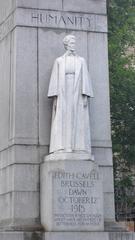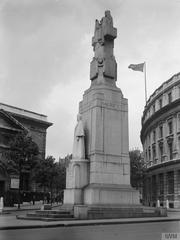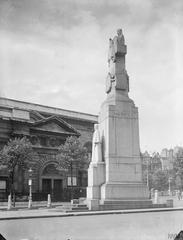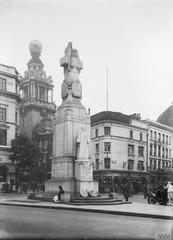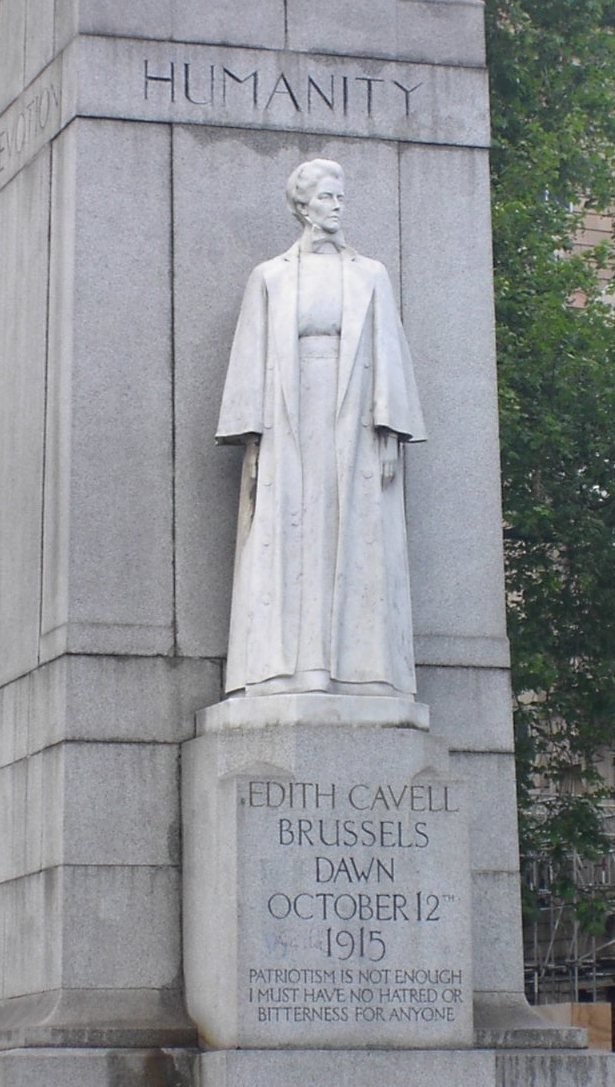
Edith Cavell Memorial Visiting Hours, Tickets, and London Historical Sites Guide
Date: 15/06/2025
Introduction
The Edith Cavell Memorial in London stands as a deeply moving tribute to one of World War I’s most celebrated heroines, Nurse Edith Cavell. Executed by German forces in 1915 for helping over 200 Allied soldiers escape from occupied Belgium, Cavell’s story became a symbol of courage, compassion, and forgiveness. The memorial, located at St Martin’s Place near Trafalgar Square, is among the earliest monuments dedicated to a woman from the Great War. Designed by Sir George Frampton, who waived his fee to honor Cavell, the monument features a white marble statue of Cavell in her nurse’s uniform set against a granite cross—symbolizing solemnity and resilience (Wikipedia; Victorian Web; Historic England).
Accessible 24/7 and free to the public, the memorial serves as a site of remembrance, education, and reflection. Its central location, adjacent to Trafalgar Square and near other major attractions like the National Portrait Gallery and the British Museum, makes it an essential stop for anyone exploring London’s rich history (English Heritage; Stuff About London).
Table of Contents
- Introduction
- Historical Background of the Edith Cavell Memorial
- Visiting the Edith Cavell Memorial
- Nearby Attractions and Photographic Spots
- Preservation and Contemporary Relevance
- Related Memorials and Broader Commemoration
- Frequently Asked Questions (FAQ)
- Plan Your Visit and Stay Connected
Historical Background
Conception and Immediate Impact
The origins of the Edith Cavell Memorial are rooted in the profound international shock following her execution on October 12, 1915. Cavell, a British nurse, was executed for aiding Allied soldiers’ escape from German-occupied Belgium—a deed interpreted as treason by German authorities (Wikipedia; Red Cross UK). Her death was widely condemned, sparking public outcry and solidifying her legacy as a humanitarian and martyr.
Immediate calls for a permanent memorial reflected the depth of admiration for her courage and compassion. A committee was promptly formed to commission a monument to immortalize Cavell’s sacrifice (Historic England).
Commissioning and Design
Sir George Frampton, one of the era’s foremost sculptors, was commissioned in 1915. Frampton declined any fee, emphasizing his respect for Cavell and the importance of the project (Stuff About London). The memorial was strategically placed at St Martin’s Place, opposite the National Portrait Gallery and near the original headquarters of the British Red Cross (Learn About War Memorials).
Frampton’s design features Cavell in her nurse’s uniform, carved from white Carrara marble, standing before a tall granite pylon with a sculpted cross. Above, a figure of a mother and child symbolizes compassion and sacrifice (Historic England).
Unveiling and Early Reception
The memorial was unveiled on March 17, 1920, by Queen Alexandra, witnessed by a large crowd, including many nurses and dignitaries. The site quickly became a focal point for annual commemorations, particularly among the nursing and medical communities (Barts Health NHS Trust).
Symbolism and Inscriptions
The monument is rich in symbolism. The front inscription reads:
“Edith Cavell/Brussels/Dawn/October 12th/1915.
Patriotism is not enough/I must have no/hatred or bitterness for anyone.”
These are Cavell’s last recorded words, embodying her legacy of forgiveness and humanity (Wikipedia; Learn About War Memorials). The sides of the memorial bear the words: “HUMANITY,” “SACRIFICE,” “FORTITUDE,” and “DEVOTION” (Historic England). The statue itself was modeled on Cavell’s sister to ensure a close familial resemblance.
Visiting the Edith Cavell Memorial
Location and Accessibility
- Address: St Martin’s Place, London WC2N 4JN, near Trafalgar Square and the National Portrait Gallery.
- Accessibility: The memorial is wheelchair accessible, with level pavements and clear signage (Evendo).
Visiting Hours and Admission
- Opening Hours: The memorial is outdoors and accessible 24/7. For safety and best viewing, daylight hours are recommended.
- Admission: Free to all visitors.
How to Get There
- By Tube: The nearest Underground stations are Charing Cross and Leicester Square, each within a 5-minute walk.
- By Bus: Multiple bus routes serve Trafalgar Square.
- By Foot: The memorial is easily reached on foot from nearby attractions, including the National Gallery and St Martin-in-the-Fields (National Portrait Gallery).
Guided Tours and Special Events
- Guided Tours: Many walking tours of London’s historical sites include the Edith Cavell Memorial. Some audio guides are available via mobile apps.
- Annual Events: Wreath-laying ceremonies are held every October 12th, the anniversary of Cavell’s execution, and on Remembrance Sunday.
Nearby Attractions and Photographic Spots
The memorial is situated among London’s most iconic sites:
- Trafalgar Square
- National Portrait Gallery
- The National Gallery
- St Martin-in-the-Fields
- British Museum (a short tube or bus ride away)
Photographers will find excellent vantage points with the statue and Trafalgar Square as a backdrop, especially during morning or late afternoon light.
Preservation and Contemporary Relevance
The Edith Cavell Memorial has undergone conservation work, most notably in 2014, to ensure its preservation for future generations (Learn About War Memorials). The site remains a focus for remembrance and educational visits, highlighting women’s contributions and humanitarian values (Historic England).
Related Memorials and Broader Commemoration
Cavell’s legacy extends beyond London, with numerous memorials and dedications across the UK and abroad:
- Grave and memorial at Norwich Cathedral
- Memorial bench in Hunstanton
- Stained glass window in Swardeston, her home village
- Wards and institutions named in her honor (Learn About War Memorials)
Frequently Asked Questions (FAQ)
Q: What are the Edith Cavell Memorial visiting hours?
A: The memorial is accessible 24 hours a day, every day. Daylight visits are recommended.
Q: Is there a fee to visit the Edith Cavell Memorial?
A: No, admission is free.
Q: How do I get to the memorial by public transport?
A: The nearest Tube stations are Charing Cross and Leicester Square. Several buses serve Trafalgar Square.
Q: Are guided tours available?
A: Yes, many London walking tours include the memorial. Audio guides may also be available.
Q: Is the memorial wheelchair accessible?
A: Yes, the area is step-free and suitable for wheelchair users.
Plan Your Visit and Stay Connected
Whether you’re a history enthusiast, a student, or a tourist, the Edith Cavell Memorial offers a profound opportunity for reflection on courage, sacrifice, and compassion. Enhance your visit by exploring nearby attractions and considering guided or audio tours. Download the Audiala app for audio guides, walking tours, and real-time updates on events. Follow us on social media for the latest news, commemorative events, and travel tips.

Alt text: Front view of the Edith Cavell Memorial in London, featuring a white marble statue of Edith Cavell in nurse’s uniform against a tall grey granite cross.
Summary
The Edith Cavell Memorial stands as a timeless reminder of humanitarian courage and self-sacrifice. Its central location, free and continuous public access, and educational value make it an essential destination for visitors seeking to connect with London’s rich heritage. The memorial’s poignant inscriptions and dignified design by Sir George Frampton continue to inspire reflection and remembrance. Enhance your experience by exploring related London sites, attending commemorative events, and using resources like the Audiala app for guided tours.
References and Further Reading
- Wikipedia
- Red Cross UK
- Historic England
- Stuff About London
- Victorian Web
- English Heritage
- London Remembers
- Waymarking
- Learn About War Memorials
- Evendo
- National Portrait Gallery
- Barts Health NHS Trust
- Touristlink
